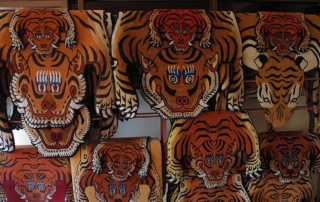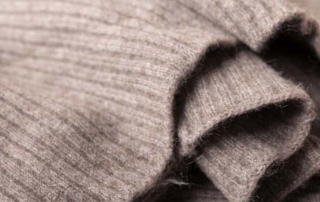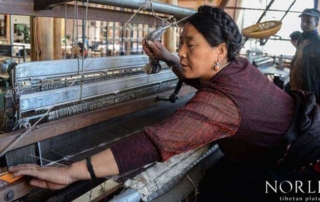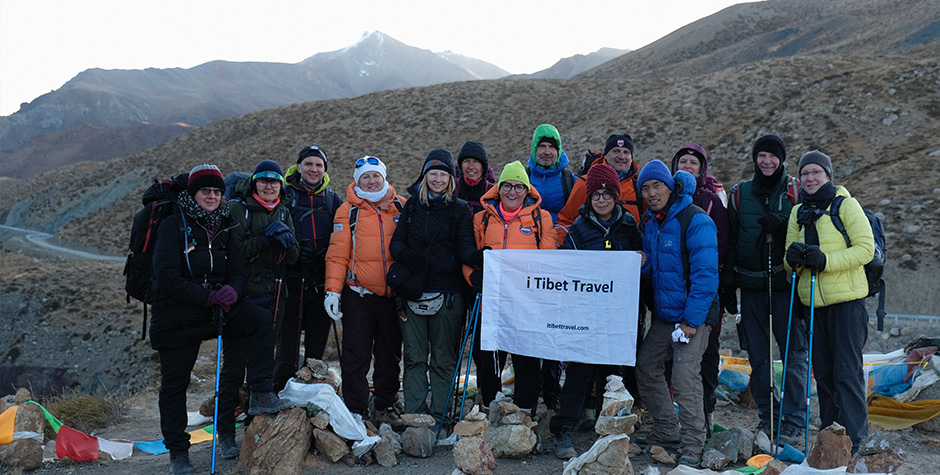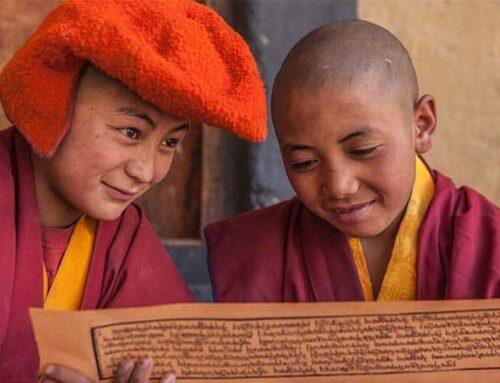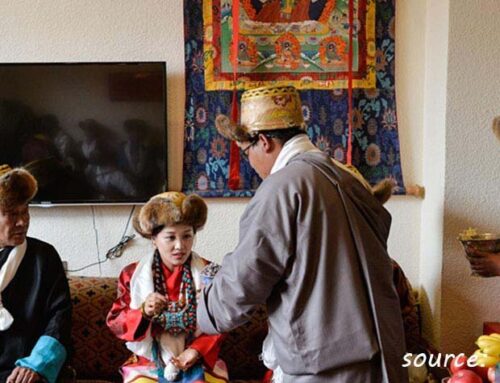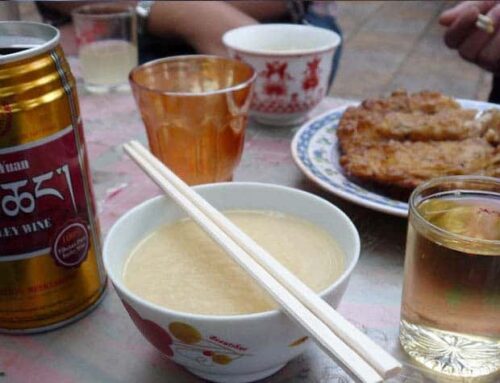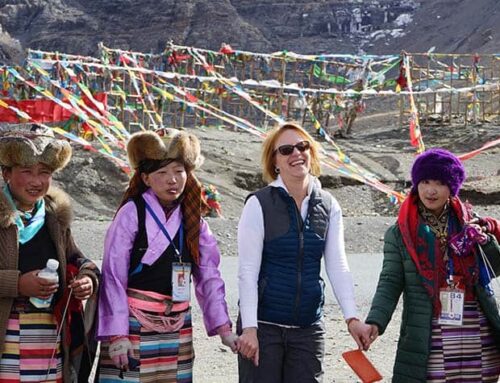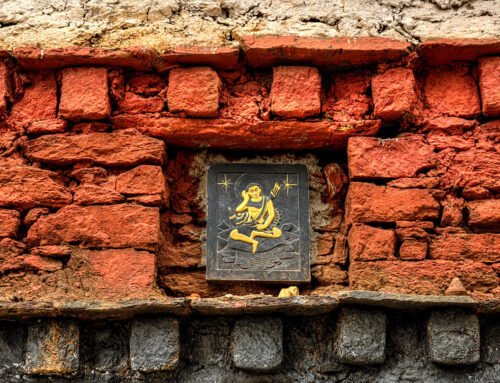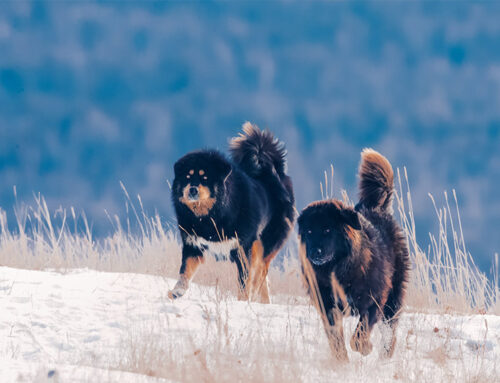Tibetan Weaving history is a long and prosperous one. We have developed our unique method of weaving. The historian can trace Tibetan weaving to the 7th Century. What is so interesting about Tibetan weaving is that we have developed a unique way of making clothes and rugs which is entirely different from any other surrounding regions. In Tibet, we use local wools from the Yak and Sheep for weaving. We produce different kinds of clothes and rugs for over centuries.
History of Tibetan Weaving
Many historians believe that the Princess Wencheng first introduces weaving in Tibet in the 7th century. Tibetan King Songtsan Gampo wants to add many skills from other parts of China, Nepal and from India to make life in Tibet more progressive. His wife from the Tang Dynasty has helped introduce many arts and skill into Tibetan Society, and Weaving is one of the profession she helps introduce in Tibet.
Tibetan weaving technique had been well established, and it does not appear to be influenced by other well-established regions of Persian and Other Parts of China. Here in Tibet weaving was done out of requirement and weaver create Rugs as saddle covers, curtain for the window, sleeping mat, and another utility purpose. Besides exceptions of royalty, high lamas and aristocrat family, Tibetan weaving is not for elegance and decorative. Clothes and rugs are usually produced for household use and never meant for selling and export, which is why old Tibetan clothes and carpets are scarce to find.
In old-time Tibetan clothes and rugs are woven often in three basic sets of design: A primary and Simple design for household consumption, Tiger design and Elegant Design with the influence of Chinese design. In the old day, we have minimal access to dyes which is why Tibetan clothes and rug are straightforward in design and Color. The more elegant design takes influence from the Chinese Design with use of images as dragon and lotus flower.
One unique Design in Tibet is the Tibetan Tiger rug. These mats are for Lamas as a prayer mat. In Tibetan Buddhism, Tiger is a revered, and it is believed to protect them during practice and meditation.
Sociological Background of Tibetan Weaving
The most household in traditional Tibet is self-sustaining and Often produce what the need in their home is. The man in the family is considered as the Outer wall of the family. The man would go out to look after the animals, do the business outside and look after the field. Women are considered as the inner pillar of the family. She would look after the Children, Milk the Dri (Female of yak, Yaks are male). And often in her free time, she would weave clothes and Rugs for the family. The wool used in weaving is usually from the Domestic yaks and Sheep.
The skills of the craft of weaving are passed down from the generations to generation. It often requires the bride to know all these skills before marrying off to the Husband family. Since all the traditional Tibetan family is a joint family and family size is enormous. Hence the bride would require a very good in weaving. The Husband and parent of the husband family would often show off the excellent work done by their new bride during the social gathering and Tibetan New years, Which is why it is essential for the bride to learn these skills at the best before marriage. Read more about Tibetan marriage here.
In old Tibet, Our Tibetan society is an estate base society. Many villages and Nomads often belong to the aristocrat family in Lhasa. If the family belongs to a particular estate, the family members have to go their master hold to pay their tax in service along with other taxes. Hence they will have to go and make those elegant clothes and rugs for their master’s family in Lhasa and other bigger cities.
Gyantse is one of the estates where there is the mass production of the clothes and rugs to be used for Regional Tibetan government in Lhasa and most of the most significant monasteries in Tibet. Here the slaves would work to produce to supply for these demands.
Clothes Weaved in Tibet
Most clothes are produced with wool from Yaks and Sheep. Most garments are produced only for domestic consumptions. Generally, the woolen Clothes produces in Tibet are of five kinds. This differentiation is base on the finest of the clothes and the purpose.
-
Ba (སྦྲ་)
Ba is the thickest of all the clothes made in the Tibetan family. It is often used as the Nomad Tent and Outer curtain for the main building in the monasteries and Palaces, Especially the Potala Palace in the Winter. One of the most prominent characteristics of the Ba cloth is, During the warm season the fiber of the Ba would loosen up, and it becomes breathable. In the cold season in the winter and during the raining season the Ba fiber would tighten up to block the Cold air coming into the structure.
Each nomad family would stay in a tent made of Ba. Another widespread use of the Ba is to use as the Outer curtain for the main building of Monasteries and Palaces. It helps prevent against the cold winter wind and dust. It is also useful to prevent Tibet’s Sun in fade the beautiful Tibetan wood painting works along with the frames of the windows and doors.
-
Lüw (Tibetan Yak wool Blanket)
Every household in Tibet has Lüw. It is popularly known as the Tibetan Yak wool blanket. It is made in the home and it is very hard to find in the market. If we want it we will have to order it from the relatives in Tibetan Villages. Most travel agencies use it during the trekking in Tibet.
It is thick and heavy. Due to its heaviness, it is very warm to wear above the normal blanket. -
Tsuptruk
Tsuptruk is a Tibetan blanket which is traditionally used everywhere in Tibet. It is thick and heavy. The outer layer is smooth and the inner layer is hairy. Tsuptruk is not made every year as compared with other clothes, but it is always made in the home when the new one is needed. Like Lüw, Tsuptruk is normally not available in the market.
-
Nambu (སྣམ་བུ་)
Nambu is the most common fabric used in old Tibet for Making a dress. It is a little thicker and easier to make. Since it takes less time to make, it is cheaper in the market and hence commonly used by ordinary people and ordinary monks to make their dress. It is also used to make Tibetan boot called Sumba. Since it is less refined and release lots of hairs, It can only be a wash to clean it. Nambu is used in Central Tibet for making the apron for the Ladies and also apply for making Tibetan boot call Sumba
Nowadays It is commonly used in making Ladies handbags and gift to buy as the souvenir by a tourist. You can find a lot of products made by local from the Nambu fabric. -
Shedma (ཤད་མ་)
Shedma is the finest clothes woven with wool. It is so subtle that it takes a lot of labor time to produce. So it is more expensive. Only used by the well-off families to make their dress. The high lamas and Aristocrat family often use it. Since it is weave with much care. The texture of the Shedma is so soft in touch and shiny. The value of the Shedma is generally base on the finest, softness and shine on the surface.
To keep the shine of the texture, we would make a Pak (Dough of Tsampa) and roll it on the cloth to take away the dust and other impurities from the Cloth. Shedma is also using in making the apron for Ladies in the Lhasa region and Boots for higher and more affluent people.
Tibetan Rugs
Tibetan Rugs is the prevalent amount the International travelers. During the earlier time in Tibet tourism, Tibetan Rugs is a huge popular demand for International visitors.
As in Tibet, I don’t remember any family how does not use rugs. Traditionally like weaving clothes, Weaving Rugs is also passed down from the generation to generation. We often tell, we can judge, how well a family is doing by the quality of the Rugs in their home. So having good rugs in the family is a status symbol in front of the visiting guest especially during the Tibetan New Year and other social ceremonies. While your visit to Nomad and Tibetan family in Village, you will often see all the household using rug off the bed.
The historian has a different view on how Tibet has developed its unique style in weaving rugs. Some believe Persia influences it. The popular thinks the weaving carpets and clothes are brought to Tibet by the princess Wencheng in the 7th century when she married Tibetan King songster Gampo.
As time pass by, we have developed our uniques local ways and skills in weaving the rugs too. Tibetan made the Rugs for different utility purpose, Mat for the meditating monks, mat on the bed, Floor mat, window, and door cover during the winter and it is often used as a wall hanging.
The most popular Tibetan rugs in the modern market are Tibetan Tibet Rugs. Tiger is a revered animal in Tibetan Buddhism. The monks only use the Tiger rugs in the old times. It is believed that the Tibet will protect them from the Negative elements while they meditate or practice.
Another popular Tibet Rugs is called Wangden Rugs. It is a loosely weaved rugs with lower Knot count and Thicker pile than other Tibetan Rugs. This type of carpet is used in monasteries as a sitting carpet in the assembly hall. Nowadays this rug is made in Wangden valley of Shigatse. The most popular place where you will find this carpet is at the entrance of 13th Dalia lamas Quater in Potala Palace.
During your Tibet travel, We would strongly recommend you in visiting Tibetan Rugs producer in the town of Gyantse, which has hundreds of year in history. If your interest we offer the custom-made Tibet culture tours for visiting Tibetan handicraft centers, Tibetan family in Village and Nomad.
The process of Weaving Tibetan Clothes and Rugs
Production of Tibetan Clothes and rugs is a very labor intensive and a very lengthy process. Traditionally it is all made with a bare hand. From getting wool from the Yaks and Sheep to the finish, the product could take many months and even a year in manufacturing. Which is why in the old times. A family member would take a turn each year to use the finished product.
-
Sorting wool and washing
The first step in the weaving is sorting the wool. First, they would handpick all the foreign elements like grass and woods. After the non-wool particle is picked, they would short the pieces of wool to be used in the different products. Finest wool will go for the production of Shedma, and thicker wool will go for the production of Ba and Rugs as per the product requirement. After the wools are sorted. It will be washed in warm water. Warm water helps to soften the wool and retain its character.
-
Wool carding
It is a process of combing the wool is the wool to separate the jointed wool and remove impurities, if any remains. Carding also helps make the wool soft ready to yarn. Carding comb is made with the wooden plank with metal needles.
-
Spinning
The next step in the Tibetan weaving is spinning. In this process, the wool is converted in Yarn using a simple tool of a wheel called Korlo. The wool is twisted into the desired thickness of the yarn. The selection of the Wool and thickness of the Yarn is decided as per the thickness of the product. If the weaving is for Shedma (Fine Clothes), They will make a very fine yarn. If the weaving is for the Rugs and Ba, They would thick hair and make the yarn thick.
-
Dyeing
After the spinning process, the yarns are set for dyeing. To ensure the best result from the dyeing process, the Yarns are wash one more time before the Dyeing. For dyeing, We used mineral and vegetable colors. The Most common and cheap color for dyeing is Black and maroon color. Which is the product of these colors are plenty and if you see an old picture of Tibet, you will every ordinary people are wearing maroon colored Chupa (robe). In the process of dying the yarn in cooked in a huge metal pot with the colored waters.
-
Weaving
To weave Ba, there is no requirement for any machine. Nomads and Villagers as set up the weaving thread with the minimum requirement and can be made in any space. It is not a very lengthy process too.
To Weave Shedma and Nambu, we used to draw loom which could be not more than the dimension of 1 meter each direction. The process of weaving could be long base on how excellent the final products need to be.
To weave Rugs, Tibetan weaver would use the weight loom. They follow the specific design pattern to use the different color yarn for images on the rugs. The most popular Tibetan rugs design is the Tibet Rug. Both processes need great craftsmanship.
After the rugs are weaved. The craftsmen would clip the edge of design using the scissors. This process makes the design visible and elegant look. Other surfaces would also be cut and smoothen using big scissors.
The rugs and cloth will be washed a few times after that to get the design shade and shape.
-
Stretching
After the clothes and rugs are finalize. It will be stretched from the four corners by four individuals. It helps to retain the perfect shape of the Rugs and Clothes. Nowadays they use the machine to do the stretching to better performance in stretching.
Read more about Tibet Travel Information and Tibet Tours. Please visit our blog: Nomadictibet.com
About Tibet Travel & Tours
Tibet Travel & Tours is a local travel agency in Tibet that offers unique and authentic experiences to travelers from all around the world. As a leading tour operator in Tibet, we provide high-quality Tibet Travel services that are tailored to our clients’ needs and preferences.
Our team of experienced and knowledgeable professionals strives to ensure that our clients have a hassle-free and memorable trip in Tibet. We specialize in various types of tours, including cultural tours, trekking and hiking tours, and adventure tours.
Our commitment to providing exceptional service has earned us a reputation as one of the best local travel agencies in Tibet. Contact us today to plan your unforgettable trip to Tibet.
Explore Tibet with a local Tibetan Travel Agency
If you’re looking to explore Tibet, starting your journey with a reputable Tibetan travel agency in Tibet is crucial. Tibet Travel & Tours is a great choice to begin your adventure with their extensive knowledge of the region and commitment to responsible tourism.
Their Tibet tour packages cater to a range of interests and budgets, making it easy to plan a trip that suits your needs. Before embarking on your tibet tour, it’s essential to have the right Tibet travel information and necessary documents, including a Tibet travel permit.
The Tibet Travel Planner provided by i-Tibet travel is an excellent resource to plan your trip, including tips on what to pack, where to stay, and what to see.
For beginners, the “About Tibet” guide provided by i-Tibet travel offers a comprehensive overview of the region’s history, culture, and top attractions. So, start your Tibet travel plan here with i-Tibet travel and discover the magic of Tibet for yourself.

